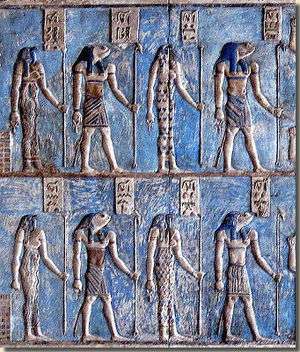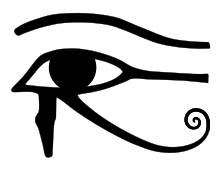This article is about the deities in Egyptian mythology. For the concept in Gnosticism, see
Ogdoad (Gnosticism).
In Egyptian mythology, the Ogdoad (Greek ογδοάς "the eightfold", Egyptian Khemenu, Ḫmnw) were eight primordial deities worshipped in Hermopolis during the Old Kingdom period (27th to 22nd centuries).
While there is no doubt as to the antiquity of this group of gods, such that even at the time of composition of the Pyramid Texts towards the end of the Old Kingdom period they were antiquated and forgotten by everyone except religious experts, the oldest known pictorial representations of the group do not predate the time of Seti I. Budge (1904) compares the concept to a group of four pairs of primeval gods mentioned in the Babylonian Enûma Eliš.[1]
Texts of the Late Period describe them as having the heads of frogs (male) and serpents (female), and they are often depicted in this way in reliefs of the Greco-Roman period.[2]
Budge also argues that the Ogdoad is the original "company of gods" or
paut neteru, represented by nine axes (
) arrived at by augmenting the original Ogdoad by the local chief deity of
Heliopolis,
Tem, by the authors of the theological system reflected in the Pyramid Texts.
[3]_(14763536725).jpg)
Drawing of a representation of the Ogdoad in the temple of
Philae.
[4]The eight deities were arranged in four male-female pairs (the female names being merely derivative female forms of the male names), as follows:.[5]
The names of Nu and Nut are written with the determiners for sky and water, and it seems clear that they represent the primordial waters.
Ḥeḥu and Ḥeḥut have no readily identifiable determiners; according to a suggestion due to Brugsch (1885), the name is associated with a term for an undefined or unlimited number, ḥeḥ, suggesting a concept similar to Greek aion. But from the context of a number of passages in which Ḥeḥu is mentioned, Brugsch also suggested that he may be a personification of the atmosphere between heaven and earth (c.f. Shu).
The names of Kekui and Kekuit are written with a determiner combining the sky hieroglyph with a staff or scepter used for words related to darkness and obscurity, and kkw as a regular word means "darkness", suggesting that these gods represent primordial darkness, comparable to Greek Erebus, but in some aspects they appear to represent day as well as night, or the change from night to day and from day to night.
The fourth pair appears with varying names, sometimes the name Qerḥ is replaced by Ni, Nenu, Nut, or Amun, and the name Qerḥet by Ennit, Nenuit, Nut, Nit, or Amunet. The common meaning of qerḥ is "night", but the determinative (D41 for "to halt, stop, deny") also suggests the principle of inactivity or repose.[6]
There is no clear way to attribute four functions to the four pairs of gods, and it seems clear that "the ancient Egyptians themselves had no very clear idea" regarding such functions.[7]
See also
References
- ↑ viz. Apzu and Tiamat, Lahmu and Lahamu, Anshar and Kishar, Anu and Nudimmud. E. A. Wallis Budge, The Gods of the Egyptians: Or, Studies in Egyptian Mythology (1904), vol. 1,p. 287f.
- ↑ Mark Smith, On the Primaeval Ocean (2002)
, p. 38.
- ↑ E. A. Wallis Budge, The Gods of the Egyptians: Or, Studies in Egyptian Mythology (1904), vol. 1,p. 87–93, 282.
- ↑ "Drawn by Faucher-Gudin from a photograph by Béato. C.f. Lepsius, Denkm, iv.pl.66 c.", published in Maspero (1897).
The scene is collapsed from "the two extremities of a great scene at Philae, in which the Eight, divided into two groups of four, take part in the adoration of the king."
- ↑ E. A. Wallis Budge, The Gods of the Egyptians: Or, Studies in Egyptian Mythology (1904), vol. 1,p. 283.
- ↑ Budge (1904) vol. 1, p. 283-286.
- ↑ Budge (1904) vol. 1, p. 287-288.
- George Hart The Routledge Dictionary Of Egyptian Gods And Goddesses, Routledge 2005, p. 113
- Françoise Dunand, Christiane Zivie-Coche Gods and Men in Egypt: 3.000 BCE to 395 CE, Cornell University Press 2004
- John D. Baines, Byron Esely Shafer, David P. Silverman, Leonard H. Lesko Religion in Ancient Egypt: Gods, Myths, and Personal Practice, Cornell University Press 1991
- Salmon, George (1887), "Ogdoad", in Smith, William; Wace, Henry, A Dictionary of Christian Biography, Literature, Sects and Doctrines, Volume IV, London: John Murray, pp. 71–72
External links


_(14763536725).jpg)